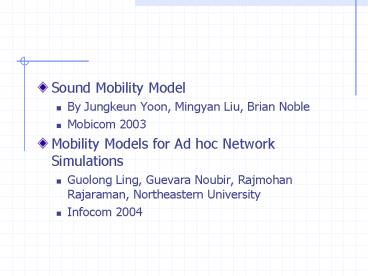Sound Mobility Model - PowerPoint PPT Presentation
1 / 30
Title:
Sound Mobility Model
Description:
... pause state, for a time period randomly distributed with certain ... Each node's movement is characterized by a non-overlapping time period X1, X2, ... – PowerPoint PPT presentation
Number of Views:44
Avg rating:3.0/5.0
Title: Sound Mobility Model
1
- Sound Mobility Model
- By Jungkeun Yoon, Mingyan Liu, Brian Noble
- Mobicom 2003
- Mobility Models for Ad hoc Network Simulations
- Guolong Ling, Guevara Noubir, Rajmohan Rajaraman,
Northeastern University - Infocom 2004
2
Sound Mobility Model
- By Jungkeun Yoon, Mingyan Liu, Brian Noble
- Mobicom 2003
- Presented by Honghai Zhang
3
Outline
- Introduction of mobility models
- Main Result
- Speed decay, Esteady speed lt Einitial speed
for some commonly used mobility model (random
waypoint) - Derivation of the result
- Eliminating speed decay.
4
Introduction to Mobility Models
- Each node selects two or more of the followings
according to some random distributions - A destination x in a space U
- Traveling speed v
- Angle ?
- Distance d
- Travel time t
- After reaching d or traveling for t, it may pause
before repeating the above process.
5
Classification of random mobility models
6
Classification of random mobility models (cont)
- Another classifications
- Entity model
- Individual nodes move independently
- Group model
- Movement of nodes in a group is correlated
7
Main Results
- Speed, time independent
- No speed decay
- Speed, distance independent
- There is speed decay
8
Initial Average Speed
- Initial State
- With probability Pmove in move state, speed is
randomly distributed in Vmin, Vmax with certain
distribution Vmin gt 0. - With probability Ppause in pause state, for a
time period randomly distributed with certain
distribution. - Pmove1 Ppause is the probability that a node
is found in move state when the mobility model
reaches equilibrium. - EVinit EVPmove
9
Speed, time indepedent
- V- speed in the move state
- V- speed in the pause state, 0
- Model the distribution of V as a delta
function, ? - Vss steady state speed.
- S time duration of moving once
- P time duration of pausing once
- R distance during one move.
10
Speed, time independent (cont)
11
Speed, time independent (cont)
12
Speed, distance independent
13
Speed, distance independent (cont)
14
Intuitive explanation
- When speed and distance are chosen independently,
a lower speed results in a longer trip. - So a node has more time in a lower-speed state.
- Average speed is weighted by travel time. Average
speed is lower than the system set average speed,
or the initial speed.
15
Eliminating Speed Decay
- Determine whether a node starts from a move state
or a pause state, with probability Pmove and
Ppause, respectively. - If a node starts from a move state, use fvss to
generate the travel speed. - If a node starts from a pause state, use fpss to
choose a pause time. - After the first trip (either move or pause) of a
node, use fv(v) or fP(p) to select all subsequent
travel speeds any pause times, respectively.
16
Simulation Results
17
Mobility Models for Ad hoc Network Simulations
- Guolong Ling, Guevara Noubir, Rajmohan Rajaraman
- Northeastern University
18
Outline
- Original Mobility Model
- Steady State Speed Distribution
- Revised Mobility Model
- Speed Distribution of the Revised Model
- Simulation results
19
Mobility Model S1A
- Each nodes movement is characterized by a
non-overlapping time period X1, X2, . - In each period X1, independently randomly choose
a distance Di and speed Vi - Distribution function of Di,Vi are FD and FV
20
Theorem 1 Steady State Speed Distribution
Function
- Vt-speed at time t.
- Fvt, fvt, is the cdf and pdf of Vt
21
Application of Theorem 1
- Random Waypoint mobility model w/o pause
- V uniformly from Vmin to Vmax
22
Thm2 Residual distance ?t
23
Revised Mobility Model S1B
- In the first period, travel speed, distance are
chosen according to - Fv?,FD?. In the remaining period, they are
chosen according to Fv,FD.
24
Thm3 Stationary Property of the Revised Model
25
Simulation Results
26
Renewal theory
- Renewal-type equation
- where H is a uniformly bounded function.
- is a
solution of the renewal-type equation. If H is
bounded on finite intervals then u is bounded on
finite intervals and is the unique solution. - , Fk(t) is k times convolution
of F(t). - Elementary renewal theory
27
Key Renewal Theory
- If g 0,?)-gt0, ?) is such that
- (a) g(t) gt 0 for all t,
- (b) ,
- (c) g is a non-increasing function,
- Xi is a non-arithmetic function,
28
(No Transcript)
29
(No Transcript)
30
(No Transcript)































